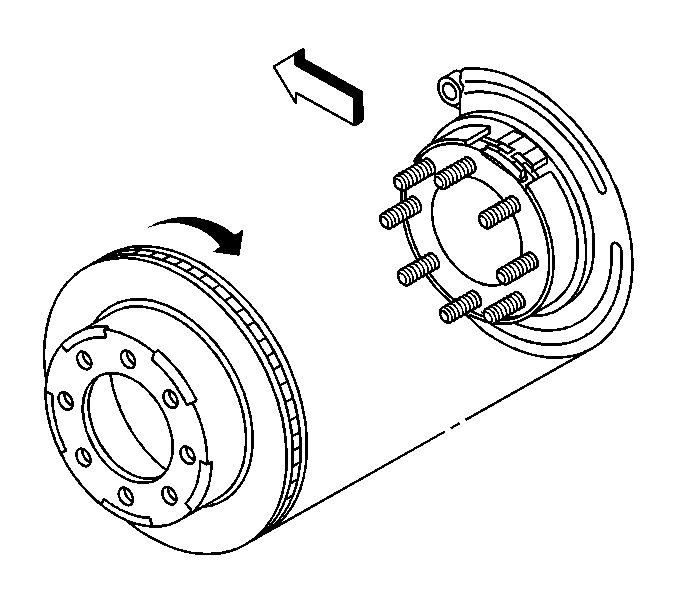Tools Required
Notice: Any new rotor must have the protective coating removed from the friction surfaces before being placed in service. Remove the protective coating using
denatured alcohol or an equivalent brake cleaner, and wipe the surface clean with clean cloths. Do not use gasoline, kerosene, or other oil base solvents which may leave an oily residue. This residue is damaging to the brake lining and is flammable.
Removal Procedure
You can remove the brake rotor without separating the caliper from the mounting bracket.
- Release the parking brake.
- Remove 2/3 of the brake fluid from the master cylinder.
- Raise and support the vehicle. Refer to
Lifting and Jacking the Vehicle
in General Information.
- Remove the tire and wheel assembly. Refer to
Tire and Wheel Removal and Installation
in Tires and Wheels.
- Remove the caliper mounting bracket bolts.
- Remove the caliper and mounting bracket as an assembly.
- Hang the caliper and mounting bracket assembly from the suspension using heavy gauge wire.

- Remove the rotor by slowly turning the rotor while pulling the rotor away from the axle.

- If the brake rotor cannot be removed perform the following:
| 9.2. | Insert
J-46277
between the rotor friction surfaces in the vent section of the rotor. |
DO NOT place the
J-46277
on the rotor friction
surface.
| 9.4. | Inspect the park brake components for the following conditions: |
| • | Bent or broken hold down spring |
| • | Broken, cracked or worn brake shoe lining |
| • | Bent or damaged brake shoe |
| • | Worn, bent or damaged backing plate |
| 9.5. | If any of these conditions are found replace the affected parts. |
Installation Procedure
- Clean all rust and contaminants from the both sides of the rotor and the hub flange.
Important: Whenever the brake rotor has been separated from the hub/axle flange, any rust or contaminants should be cleaned from the hub/axle flange and the brake rotor mating surfaces. Failure to do this may result in excessive
assembled lateral runout (LRO) of the brake rotor, which could lead to brake pulsation.
- Using the
J 42450-A
, thoroughly clean any rust or corrosion from the mating surface of the hub/axle flange.
- Using the
J 41013
, thoroughly clean any rust or corrosion from the mating surface and mounting surface of the brake rotor.
- Inspect the mating surfaces of the hub/axle flange and the rotor to ensure that there are no foreign particles or debris remaining.

- Install the rotor by slowly turning the rotor while pushing the rotor towards the axle.
- Install the caliper and the mounting bracket as an assembly to the steering knuckle.
- Perform the following procedure before installing the caliper mounting bracket bolts.
| • | Remove all traces of the original adhesive patch. |
| • | Clean the threads of the bolt with brake parts cleaner or the equivalent and allow to dry. |
| • | Apply Threadlocker GM P/N 12345493 or Red LOCTITE™#272 to the threads of the bolt. |
Notice: Refer to Fastener Notice in the Preface section.
- Install the caliper mounting bracket bolts to the steering knuckle.
Tighten
| • | For the 15 Series, tighten the brake caliper mounting bracket bolts to 175 N·m (129 lb ft) |
| • | For the 25 series, tighten the brake caliper mounting bracket bolts to 300 N·m (221 lb ft) |
- Install the tire and wheel assembly. Refer to
Tire and Wheel Removal and Installation
in Tires and Wheels.
- Remove the safety stands.
- Lower the vehicle.



